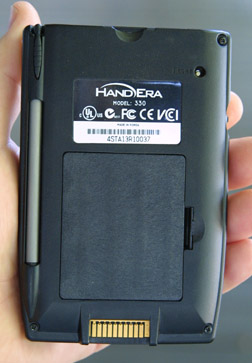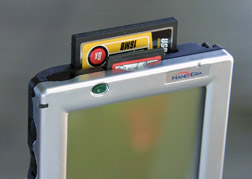The folks we used to know as TRG, makers of the TRGpro handheld,
have come out with a new product and a new name. While the name unfortunately doesn't bowl me over,
the product absolutely does. It's called the 330, and it packs a whole list of "finally's!" into a
modified Palm III form-factor. As in, "Finally! Higher resolution! Finally! Rotatable screen! Finally!
A virtual Graffiti pad that moves out of the way to give us more screen real estate! There's more,
so get ready for my brief overview.
But first, a word of thanks to HandEra for being so cool as to lift the news embargo after the leaks oozed
out on Friday. I had intended to prepare a full review over the weekend and post it in time for the Monday
announcement like I normally do, leaks or not, but now that I have the opportunity to put REAL information
up, I think I will.

Its most noticeable feature is its sharp screen (click on the photo at right or above for a closer look).
Though it sports the same resolution as PocketPC's,
its resolution is considerably more Palm-like in that you can actually read it. We're talking QVGA or
Quarter VGA, aka 240x320. There'll be a lot more detail about this to come, but suffice it to say the
screen is stunning and the Graffiti area does indeed slide out of the way to make room for more data.
Awesome. And yes, your strokes leave an ink trail until you lift the stylus and the character is recognized.
The screen can be rotated, if programs permit, and legacy programs that don't handle the special
interpolation method can be run either center screen or upper left corner in 160x160 mode.
There are a lot more fonts to choose from--eight total.
Icons can be large or small. In small mode, they fit four abreast. Oh yes, and there's a
REAL FRIGGIN' BACKLIGHT! I'm somewhat overjoyed about that.

The power supply consists of four AAA batteries, or you can use a lithium-ion battery pack. There's a jack
on the unit for a power input, or it can be charged through the cradle. The power input can also bypass
the AAA's and run the unit directly. There's a charger/alert light in the upper left.
On the upper right is the mic for the built-in voice recorder. On the back is a nifty feature: you no
longer have to unscrew the stylus top to get a reset pin, just take the point of the stylus and put it
into the wide open depression in the back. Genius.

There's a jog dial that looks like it came right off a Pocket PC. You shift the wheel up or down
to move between selections, and press in to make a selection; and unlike on the CLIE, it has a "backout"
button
so you can back out of your trail and start over. Holding the backout button for a few seconds starts the
recorder, and holding down the
toggle for a few seconds opens the contrast control.

And the main attraction, not only does it have a Type II Compact Flash slot, it also sports a Secure Digital
slot, offering compatibility with both the new and old standards in storage and expansion.
There's a lot more to tell, but those are the highlights. The units should be available before the end of
June, and will retail for US$349. A bargain compared feature for feature to other Palms, far as I can tell.
Look for my full review soon. -Shawn Barnett
Questions? Comments?

